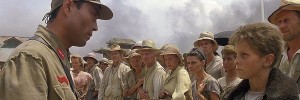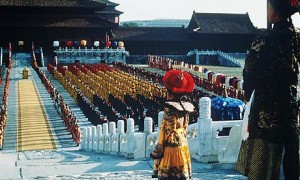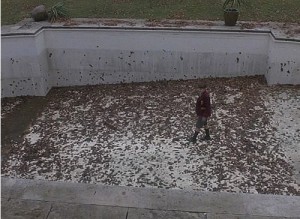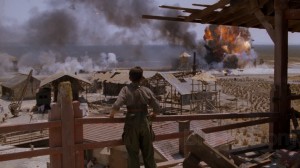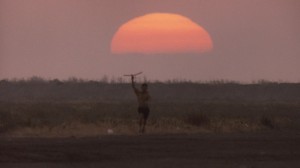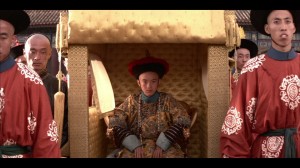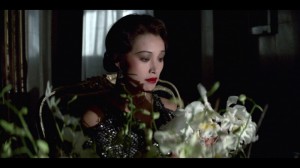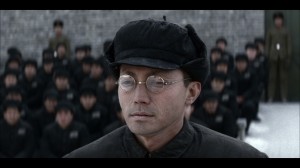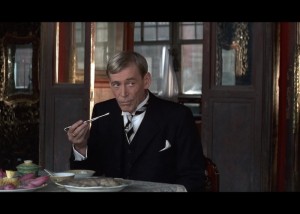From the Chicago Reader (December 18, 1987). — J.R.
EMPIRE OF THE SUN
* (Has redeeming facet)
Directed by Steven Spielberg
Written by Tom Stoppard
With Christian Bale, John Malkovich, Miranda Richardson, and Nigel Havers.
THE LAST EMPEROR
**** (Masterpiece)
Directed by Bernardo Bertolucci
Written by Bertolucci and Mark Peploe
With John Lone, Joan Chen, Peter O’Toole, Ying Ruocheng, Victor Wong, Dennis Dun, and Ryuichi Sakamoto.
“The first major Hollywood studio production ever to shoot in the People’s Republic of China” and “the first Western production to be made about modern China with the full cooperation of the Chinese government” are the two blockbusters of the season, and the dizzying gulf that stretches between them has a lot to do with the conceptual ranges of the two filmmakers who stand behind them. While the two movies need to be considered separately before they can be meaningfully juxtaposed, one preliminary generalization seems in order: while both films attack difficult subjects, Bernardo Bertolucci’s spectacular is predicated on a number of self-imposed limitations — emotional, dramatic, visual, linguistic, historical, and (more broadly) conceptual; Steven Spielberg’s, on the other hand, sprawls in the same half-dozen areas.
Empire of the Sun is based on an autobiographical novel by J.G. Ballard, an English writer whose previous work is nearly all science fiction, much of it experimental in form and most of it dealing with the curious psychological adjustments brought about by disasters. Perhaps the most consistent trait in this varied and substantial oeuvre is a certain bloodless morbidity, a capacity to look at entropic horror — the end of the world, the collapse of civilization, assassinations, car crashes, diverse technological and sociological nightmares — without blinking or flinching. (Major formal influences appear to be William Burroughs and various pop and collage artists.) Ballard’s first four novels all chart the effects of worldwide natural catastrophes, with heroes who ultimately choose to go with the flow of these events rather than cling to vestiges of the normal lives they once knew.
My introduction to Ballard’s work came about 15 years ago when I was hired to adapt one of these novels, The Crystal World, into a screenplay; my strained efforts to climb into the mind of a writer whose major poetic thrust was a romanticizing of the death wish as a universal principle left me with a lot of uneasy questions. The powerful effect of reading Empire of the Sun recently was that it answered all those questions as lucidly as I could have wished. The experiences Ballard underwent between the ages of 11 and 15 in Shanghai, as World War II disrupted his idyllic family life there, clearly provided the scenario as well as the rationale for all his fiction to come. As Ballard describes it, it took him “20 years to forget and 20 years to remember those horrendous events,” and his entire output can be inscribed within that process, with Empire providing both the climax and the skeleton key.
Whatever personal investment Spielberg has in this material — and his adaptation of it with Tom Stoppard is anything but impersonal — it was clear at the outset, when he announced this project, that his own experiences were as remote from Ballard’s as they were from Alice Walker’s in The Color Purple. Perhaps that’s why he took them on, as a challenge to master the unimaginable — a more art-conscious version of imagining extraterrestrials, roughly comparable to Disney taking on Beethoven and Stravinsky in Fantasia after proving his mettle with the stories of Snow White and Pinocchio. But it’s a foregone conclusion that his methods would have to process out much of what gives Ballard’s work its focus and purpose, just as Disney had to wind up reorchestrating The Rite of Spring. (I would dearly love to see how Spielberg would adapt my two favorite shorter Ballard pieces, both of them included in Judith Merrill’s England Swings SF: “The Assassination of John Fitzgerald Kennedy Considered as a Downhill Motor Race” and “Plan for the Assassination of Jacqueline Kennedy.”)
How, for example, could Spielberg grapple with these two characteristic sentences from Empire? “As Basie sucked at the chocolate cup with his sharp teeth, he resembled a white-faced rat teasing the brains from a mouse”; and, “A drop of blood fell from his nose into the water and was instantly attacked by myriads of small fish no larger than a match head.” And what about the thoughts of Ballard’s hero Jim, after he’s herded with others out of a Japanese prison camp and into an Olympic stadium crowded with cars, appliances, and furniture, just before he witnesses a flash of light from the atomic blast in Nagasaki? “Jim looked at the hundreds of prisoners on the grass. He wanted them all to die, surrounded by their rotting carpets and cocktail cabinets. Many of them, he was glad to see, had already obliged him, and Jim felt angry at those prisoners still able to walk who were now forming a second march party. He guessed that they were being marched to death around the countryside, but he wanted them to stay in the stadium and die within sight of the white Cadillacs.”
Needless to say, Spielberg doesn’t reproduce such thoughts, although he does dutifully reproduce both the contents of the stadium and the A-bomb flash — without clarifying whether it comes from Nagasaki or Hiroshima. And to sweeten Jim’s thoughts while retaining some of his wartime confusion, the film has him (Christian Bale) comment after the flash, “I thought it was Mrs. Victor’s soul going up to heaven.” Mrs. Victor (Miranda Richardson) is the married woman with whom Jim shares a room in the prison camp for most of the war, along with her husband, and who dies on her way to the stadium. In the novel, Jim likes and is attracted to her though he knows that “if he starved to death in his bunk she would find some polite reason for doing nothing to help him.” In the movie she’s merely cranky and unfriendly, and the press book describes her as a friend of his parents.
What, if anything, is the key to Spielberg’s bewildering adaptation? A friend once remarked that in The Color Purple the central house became at different times a mansion or a shack, depending upon the dramatic needs of separate scenes. In Spielberg’s Empire, World War II is blessed with the same magical elasticity — sometimes it’s fun (Jim loves airplanes), sometimes it’s horrible (people die), sometimes it’s picturesque (over 15,000 extras), but almost never, as in Ballard, is it all of these things at once. Ballard’s vision can be described as antiwar only because of the sustained ironic and psychoanalytic distance he keeps from his crazed younger self — something that understandably took him 40 years to achieve. Spielberg intermittently toys with traces of this irony, but is perfectly willing to chuck it out the window whenever it gets in his way (which is often — his passionate identification with Jim is paradoxically the reverse of Ballard’s detachment), so that it makes no sense at all for him to claim that this is “an antiwar story, not just of a single war but of all wars.”
Any moral vision, like any coherent style, demands the suppression of certain elements as well as the persistence of certain others, but Spielberg’s anywar or everywar veers in so many directions that it ultimately becomes any movie or every movie: “Spielberg” becomes the only persistent form of coherence, which means that everything else that the movie is about — including World War II and wars in general — becomes incoherent beyond the borders of a single sequence. There are undeniable scenic splendors in the portions shot in Shanghai (which took only three weeks — the remainder was filmed in Spain and England), but the overall lack of focus makes one understand Todd McCarthy’s remark in Variety: “Steven Spielberg delves deeply into the well of seriousness in Empire of the Sun and comes up with about half-a-bucket.”
Oddly enough, some of the best filmic ideas in the novel, which might have lent Spielberg’s scattered notions some poetic unity — most notably the silent “newsreel” war dreams that Jim has before the war, which are already mentioned in the novel’s second sentence — are completely bypassed. Instead, the viewer is provoked into wondering if life in a Shanghai detention center is all that bad if the place is blessed with Spielberg lighting — which resembles the starship at the end of Close Encounters more closely than anything in Shanghai in 1941. The point isn’t that Spielberg should have stayed at home; the fact is, he never really left.
One anomaly in Spielberg’s film is that there’s a fair amount of untranslated Japanese spoken between Jim and his captors in the prison camp. By ironic contrast, all of the dialogue in The Last Emperor — a film that goes much farther in introducing us to a remote foreign culture — is entirely in English. This requires some adjustment on our parts, but once accepted, it allows Bertolucci and his scriptwriter Mark Peploe to remain firmly in control of a story that covers over 60 years of modern Chinese history. And by following the life of a man who remained at once marginal and central to that history — Pu Yi (John Lone), China’s last emperor (1906-1967) — the film can deal with both our marginal relationship to that history as Westerners and the centrality of that history to world culture.
Pu Yi’s marginality and centrality to China both stemmed from the same fact: that he was designated a symbol of imperial rule, at a time when imperial rule was virtually out of date. In 1908 at the age of three, Pu Yi was named tenth Qing emperor by the empress dowager Tzu Hsui. From this point on he was to remain a symbol, even though his emblematic importance changed in relation to the major upheavals he lived through: the birth of the first Chinese republic in 1912 (which effectively brought an end to his rule, but kept him confined in the Forbidden City for 12 more years), his expulsion from the Imperial Palace in 1924, his installation as puppet emperor of Japanese-run Manchukuo in 1933 (which ushers in the decadence and art deco styling of Bertolucci’s The Conformist), his five years in a Siberian prison camp (1945-50), his “reeducation” in a Chinese prison (1950-59), his release as an ordinary citizen in 1959, and his last years as a gardener and researcher, which overlapped with the beginnings of the Cultural Revolution. (The film elides the research job, and on the whole is selective rather than comprehensive.)
As a passive victim and prisoner of his symbolic position for most of his life, Pu Yi does not make a conventional hero, and as a personal story, The Last Emperor is infused with a sense of loss and melancholy that reflects some of Bertolucci’s own alienation from present-day Italy, as well as the theme of a lost childhood paradise that has haunted much of his work since Before the Revolution (1964). But it is important to stress that one of the remarkable achievements of this uncommonly ambitious film, which might have been called After the Revolution, is to broach areas that exist beyond the personal — a reasonable enough notion if one acknowledges that no word for “privacy” exists in Chinese — and viewers who complain about the “narrowness” of the plot might do well to look through Pu Yi’s story rather than simply at it, to perceive the richness that lies on the other side. For Pu Yi’s function in the film is partially that of a conduit or lever into a broader social reality — a reality that the film mainly depicts through indirection, but which is nevertheless central to its subject and meaning.
Two fundamental keys to this conception can be found in aspects of the film’s respective handling of space and time. Our perception of the Forbidden City, which dominates the first part of the film, is largely predicated on Bertolucci’s refusal to show us a single all-encompassing view of it. This point was perceptively brought out by Pauline Kael, who uses it, however, as a strike against the movie: “Peter O’Toole has said that it wasn’t until the movie was actually being shot and he was riding on a golden palanquin, ten feet in the air, that he saw the Imperial Palace as ‘a sea of yellow triangular and rectangular loops,’ and realized that the whole Forbidden City was intended to be seen from the height of a palanquin — that it was a maze designed for lordlings, not earthlings. I don’t understand why the moviemakers didn’t get the camera up there. What better way for Bertolucci to show us the true meaning of a life of privilege?”
One could argue that the true meaning that Bertolucci is after concerns not that of a life of privilege — the subject of Before the Revolution — but of the historical fate of a symbol. A high-angle shot of the Imperial Palace would have invited us to share Pu Yi’s illusion of power and mastery over China — just the sort of Hollywood chutzpah that the film is at pains to avoid, and with good reason, though it still offers us the most ravishing color spectacle of any Western film made this year (with 19,000 extras — even more than in Empire). Significantly, Bertolucci does show us an overhead shot of a toy model of the palace, when Pu Yi is being instructed as a child, which is a good deal more apt. From the vantage point of today’s China, the palace is a toy, and any view that attempted to persuade us otherwise would have to come from an earlier period.
This brings us to the film’s handling of time. The story is mostly conveyed in flashbacks from the period of Pu Yi’s “reeducation” in a Chinese prison in the 50s, yielding a narrative of parallel and alternating plots, and a dialectical structure that shapes our whole reading of his life. The process by which the putative onetime ruler of nearly half the world’s population becomes an ordinary citizen can obviously be interpreted in a number of ways — as defeat or liberation, brainwashing or reeducation — and Bertolucci leaves it to us to decide whether Pu Yi ultimately breaks free from his symbolic identity or merely becomes a different kind of symbol. Conscientiously avoiding propaganda and attempting a balanced view, Bertolucci shows Pu Yi being dealt with harshly as well as humanely in prison, and there’s certainly some historical irony when, after his release, he encounters the kindly prison governor Jin Yuan (Ying Ruocheng) being victimized by the Red Guard — although one wishes that the film had clarified the fact that Jin Yuan’s persecution was provoked by his support of Pu Yi.
“In my view,” Bertolucci has said, “the brainwashing story corresponds to a sort of forced psychoanalytical itinerary.” Freud and Marx have both been percolating in his work for some time, often in competition with one another, but The Last Emperor combines them in the same fluid process, which translates psychoanalytical categories into social ones. The hero’s forced separation from his family as a child — an event viewed solely in traumatic terms in Spielberg’s film — anticipates the substitution of the state for the family that is part of China’s history, and seen from the vantage point of Pu Yi’s reeducation, it becomes a necessary stage in his social integration. When Jin Yuan observes that Pu Yi’s former servant is still dressing him, he moves the ex-emperor to another cell, and Pu Yi protests that he’s never been separated from his family before — an illogical statement unless one realizes that the servant is only the most recent in a long line of family surrogates that has also included his wet nurse, wife, and concubine. By the same token, Jin Yuan becomes a father substitute as well — duplicating the role formerly played by a Scottish tutor (Peter O’Toole) — albeit a final transitional one. (The real-life Jin Yuan, who served as a consultant on the film, is cast as the prison official who hands Pu Yi his release.)
The film is tightly and brilliantly structured around rhyming effects of this kind between imperial and communist, personal and social values — there’s even a relationship between the devoted study by eunuchs of the baby emperor’s excrement and Jin Yuan’s instructions to Pu Yi on how to urinate at night without waking fellow prisoners — and the hero’s reeducation implicitly becomes our own reeducation about contemporary China. One crucial stage in this development occurs in prison when Pu Yi sees himself as Manchukuo’s puppet emperor in a newsreel about the war, and two versions of the hero are literally brought face to face.
“You’ve saved my life to make me a puppet in your play,” Pu Yi asserts to Jin Yuan — echoing his comment as emperor after expelling thieving eunuchs from the palace: “The Imperial City has become a theater without an audience. So why did the actors steal all the scenery?”
“Is that so terrible?” Jin Yuan replies in the prison yard. “To be useful?” One might pose a similar rhetorical question about the Spielberg and Bertolucci films alike. Is it so terrible to question their use in teaching us something about the other side of the world? At best, apart from a few snapshots, Empire of the Sun teaches us something about the inside of one director’s brain. The Last Emperor incidentally and secondarily does that too; but it also teaches us something about the lives of a billion people with whom we share this planet — and better yet, makes us want to learn still more about them.

